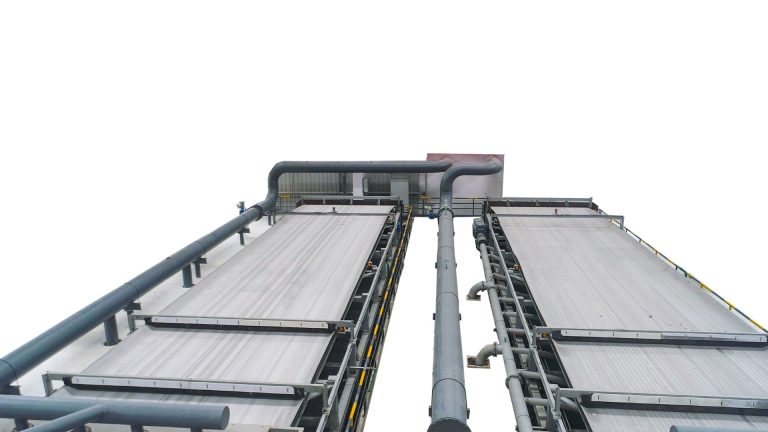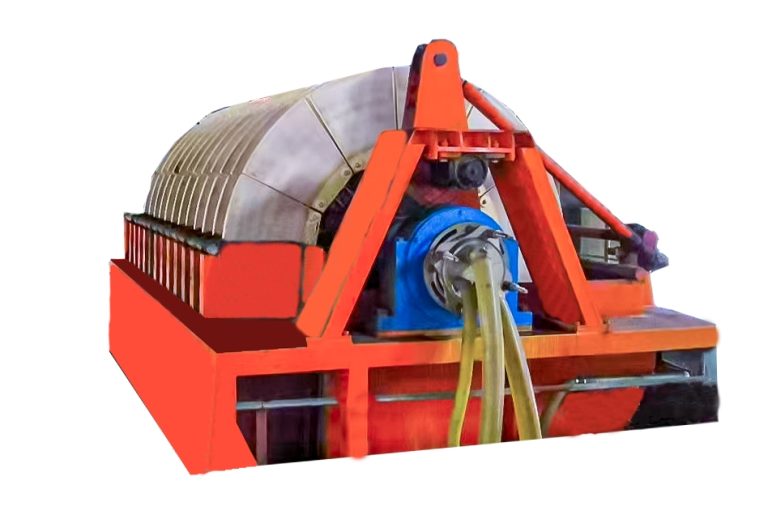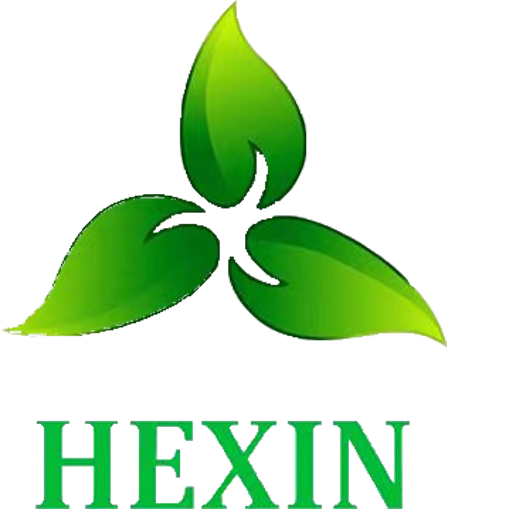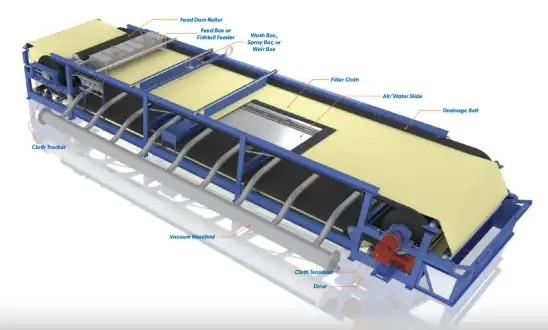
Sistemas de filtración de cinta Se han convertido en un componente clave en las actividades mineras actuales, proporcionando una separación sólido-líquido económica al tiempo que mejora la sostenibilidad ambiental. Al utilizar la filtración asistida por vacío, estas instalaciones extraen eficientemente agua de la lechada y los residuos, reducen el uso de energía y reducen los residuos, alineando la eficacia operativa con el estricto cumplimiento regulatorio. Yantai Hexin Environmental Protection Equipment Co., Ltd. demuestra el avance en este dominio, suministrando unidades de filtración de cinta fuertes y adaptables diseñadas para aumentar el rendimiento en varios usos mineros.
¿Cómo funcionan los sistemas de filtración de cinturón en las actividades mineras?
Las unidades de filtración de cinta son instrumentos esenciales en las actividades mineras actuales, proporcionando respuestas eficaces de separación sólido-líquido. Su estructura y función están personalizadas para gestionar grandes cantidades de lodos y residuos, mejorar la reutilización del agua y reducir los residuos, lo que los hace cruciales tanto para los resultados financieros como para la adhesión ambiental.
Ideas fundamentales detrás de la tecnología de filtración de cinturón
El concepto fundamental del equipo de filtración por cinta es la filtración asistida por vacío. Una cinta de caucho continua viaja sobre una cámara de vacío estacionaria, llevando un paño de filtro que aisla los sólidos de los líquidos. La mezcla de suspensión se extiende uniformemente sobre la tela de filtro mediante un distribuidor. Se forma una zona de filtrado por succión cuando la cámara de vacío se une al mecanismo de vacío. A medida que la succión tira líquido a través del paño, los sólidos permanecen en la parte superior como una torta de filtro. El aparato se mueve entonces a través de las etapas de enjuague, secado y eliminación.
Principales piezas y funciones de las unidades de filtración de cinturón
Las unidades de filtración de cinta incluyen varias partes coordinadas: una cinta de goma, un paño de filtro, una cámara de vacío, un distribuidor, sistemas de limpieza y rodillos de descarga. La tela de filtro y el cinturón de goma se mueven juntos. Esto permite la alimentación continua, el filtrado, el lavado, el secado y la limpieza de la tela de filtro. Esta estructura modular permite un montaje flexible y un funcionamiento eficiente. El uso de diferentes técnicas de soporte, como el tipo de rodillo, el tipo de cojín de aire, reduce la resistencia a la fricción y prolonga la vida útil del equipo.
Variedades de unidades de filtración de cinturón utilizadas con frecuencia en la minería
Las versiones comunes incluyen filtros de cinta de goma horizontales como el filtro de cinta BF de Yantai Hexin Environmental Protection Equipment Co., Ltd., ampliamente utilizado en la manipulación de residuos y la deshidratación de yeso. Otros tipos incluyen filtros de cerámica (serie DF) para la filtración de partículas finas y filtros de prensa de torre (serie TFP) para escenarios de alta presión.
El filtro de correa BF de Yantai Hexin muestra ingeniería sofisticada con su capacidad de operación sin parada, construcción modular para un fácil transporte o instalación en el sitio y opciones para sistemas de control automático.
¿Por qué los sistemas de filtración de cinta son eficientes para reducir los gastos operativos?
Las empresas mineras adoptan cada vez más sistemas de filtración por cinta no solo por su rendimiento técnico, sino también por su gran influencia en la reducción de los costos operativos, un elemento vital para mantener la rentabilidad en medio de cambios en los precios de las materias primas.
Reducción del uso de energía frente a otras configuraciones de filtración
A diferencia de los sistemas tradicionales de filtración a presión o centrífuga que consumen energía sustancial para empujar líquido a través de los medios, las unidades de filtración de cinta trabajan bajo presión de vacío, lo que exige menos energía. El filtro de vacío horizontal es un dispositivo de separación sólido-líquido altamente eficaz. Utiliza tela de filtro como medio, logrando la separación a través de los efectos combinados de la gravedad del material y la succión al vacío.
Menos interrupciones a través del funcionamiento sin parada
Una característica destacada es el procesamiento continuo. El aparato utiliza una cámara de vacío fija, con una cinta de caucho continua alimentada por un motor que se mueve sobre la cámara de vacío. Este ciclo ininterrumpido minimiza el tiempo de inactividad asociado con sistemas de procesamiento por lotes como prensas de placas y bastidores.
Reducción de las necesidades laborales y ventajas de la automatización
La automatización ayuda a reducir los costos. El control remoto y la interacción de campo para la operación automática reduce la dependencia del trabajo manual y mejora la consistencia del proceso. La integración con los PLC (controladores lógicos programables) permite la observación y los ajustes en tiempo real.
Reducción de los costos de mantenimiento y reemplazo
Con menos componentes móviles en comparación con los sistemas centrífugos y un desgaste reducido en comparación con las prensas de alta presión, los períodos de mantenimiento son más largos. Además, varios tipos de métodos de soporte de correa de goma como el tipo de rodillo… reducir la resistencia a la fricción y prolongar la vida útil de la cinta de goma.
Las unidades de filtración de cinta de Yantai Hexin son bien consideradas por sus bajas tasas de falla y su rendimiento superior. Esto se deriva de su estricto seguimiento de las normas de calidad ISO9001 durante los procesos de producción.
¿Qué dificultades operativas pueden resolver los sistemas de filtración de cinta en el campo minero?
Las actividades mineras se enfrentan a desafíos distintos, como el manejo de grandes volúmenes de residuos de lodos mientras cumplen con rigurosas normas ambientales. Los sistemas de filtración de cinta ofrecen respuestas prácticas en múltiples áreas.
Manejo de grandes volúmenes de lodos y residuos
Las unidades de filtración de cinta están construidas para gestionar de manera eficaz grandes volúmenes de lodo sin bloqueos o paradas frecuentes de mantenimiento. Los materiales deshidratados tienen un bajo contenido de humedad, facilitando el procesamiento o el transporte posteriores.
Aumentar la recuperación de agua y la eficiencia del reciclaje
La conservación del agua es fundamental en las áreas mineras que enfrentan sequía o límites regulatorios. La filtración asistida por vacío permite una recuperación eficiente de agua de corrientes de residuos para su reutilización dentro de la instalación.
Mejorar la recuperación de materiales de las corrientes de residuos
Al maximizar la eficiencia de la separación sólido-líquido, se pueden recuperar minerales más valiosos de lo que de otro modo podría descartarse como residuos, lo que mejora el rendimiento general.
Los equipos de filtración de Yantai Hexin permiten excelentes resultados de separación en diversos tipos de minerales mediante la adaptación de parámetros de diseño basados en características minerales específicas.
¿Cómo ayudan los sistemas de filtración de cinturón al cumplimiento medioambiental?
A medida que las regulaciones ambientales se vuelven más estrictas en todo el mundo, las empresas mineras deben adoptar tecnologías que reduzcan los impactos ecológicos mientras mantienen la productividad.
Facilitar el cumplimiento normativo mediante un manejo eficaz de residuos
La deshidratación eficiente reduce el volumen de residuos que necesitan almacenamiento o eliminación, lo que ayuda a las operaciones a satisfacer los límites legales sobre los volúmenes de producción de residuos. El sistema puede ser semi o totalmente cerrado… para la gestión de sustancias volátiles, evitando las liberaciones nocivas durante el procesamiento.
Reducción del impacto ambiental mediante la reutilización del agua y la reducción del lodo
Minimizar la pérdida de agua no solo ahorra recursos, sino que también reduce los riesgos de contaminación vinculados a la descarga de efluentes en los ecosistemas circundantes.
La dedicación de Yantai Hexin a la protección del medio ambiente es evidente en su línea de productos diseñada específicamente para el tratamiento de residuos y aplicaciones de desulfuración de gases de combustión.
¿Qué elementos afectan a la eficiencia de costes de la implementación de la filtración de cinturón?
Si bien la inversión inicial puede parecer significativa en comparación con otros métodos de deshidratación, las ganancias a largo plazo a menudo superan los costos iniciales al evaluar el valor total del ciclo de vida.
Evaluación del gasto inicial frente al ahorro a largo plazo
Los costos de capital incluyen los gastos de compra e instalación de equipos; sin embargo, el diseño modular… También se puede entregar después de la instalación y la instalación, reduciendo considerablemente el tiempo de instalación.
Personalización según el tipo de mineral y las necesidades de procesamiento
El ajuste de especificaciones como el ancho de la cinta o el área de filtración garantiza el mejor rendimiento en diferentes composiciones minerales, maximizando el rendimiento mientras minimiza el consumo de energía por tonelada procesada.
Combinación con la infraestructura de procesamiento actual
La compatibilidad con los diseños de planta existentes reduce los gastos de retroinstalación mientras mantiene la continuidad del flujo de trabajo durante las fases de instalación.
Yantai Hexin ofrece servicios de proyectos EPC, incluido el diseño de sistemas de filtración personalizados alineados con los requisitos operacionales específicos del cliente, lo que garantiza una integración sin problemas en la infraestructura existente.
¿Quién es Yantai Hexin Environmental Protection Equipment Co., Ltd.?
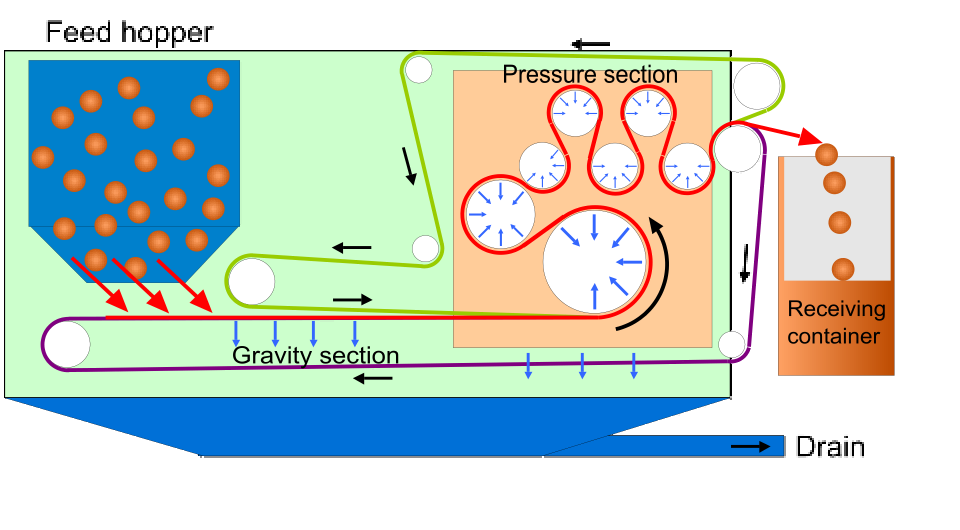
Yantai Hexin líder en soluciones de filtración industrial con casi dos décadas de experiencia al servicio de clientes mineros globales en diferentes regiones.
Perfil de la empresa y experiencia en el sector
Especializado en la fabricación de máquinas de filtro durante unos 20 años… Todos los ingenieros y gerentes son personas cualificadas. La empresa ha establecido su nombre en ingeniería precisa respaldada por tecnologías de producción avanzadas.
Dedicación a la calidad, la innovación y el servicio al cliente
La compañía pasó el sistema de control de calidad ISO9001… Se realizan tres etapas de inspección antes de la entrega del equipo. Además, se proporciona servicio posventa de por vida, incluyendo soporte en línea dentro del período de garantía de 24 horas.
Selección de productos centrados en unidades de filtración de cinta de larga duración y alto rendimiento
Su gama incluye el filtro de correa BF (tipo de vacío), Filtro de torre TFP (prensa vertical de alta presión), Filtro de cerámica DF (para partículas finas), todo construido para la longevidad en condiciones de minería exigentes.
Conclusión
Los sistemas de filtración de cinta proporcionan un método eficaz para reducir los costos operativos en la minería. Combinan un bajo consumo de energía con una alta eficiencia de rendimiento. Su capacidad para hacer frente a las dificultades de cumplimiento ambiental mientras apoya la recuperación de materiales los convierte en activos vitales en instalaciones modernas de procesamiento de minerales. Yantai Hexin’ línea de productos avanzada ofrece soluciones a medida diseñadas alrededor de Requisito específico del clientecon fiabilidad demostrada respaldada por décadas de experiencia.
Preguntas frecuentes sobre el uso de sistemas de filtración de cinta en actividades mineras
¿Qué tipos de actividades mineras se benefician más de las configuraciones de filtración de cinta?
Las actividades que implican el procesamiento de lodos de alto volumen, tales como plantas de preparación de carbón, instalaciones de concentración de mineral metálico o unidades de gestión de residuos, se benefician en gran medida de estos sistemas. Esto se debe a sus capacidades de operación sin parada.
¿Con qué frecuencia necesitan las unidades de filtración de cinta mantenimiento?
La frecuencia de mantenimiento depende de la intensidad de uso; Sin embargo, el aparato es conocido por bajas tasas de fallo, lo que sugiere intervalos más largos entre el servicio en condiciones de funcionamiento estándar.
¿Pueden las unidades de filtración de cinta manejar materiales abrasivos o químicamente duros?
- Sí. - Sí. Varios métodos de descarga líquida, como descarga cero… permitir el aislamiento o la recogida centralizada. Esto los hace adecuados incluso para entornos volátiles o corrosivos encontrados en procesos mineros específicos.



